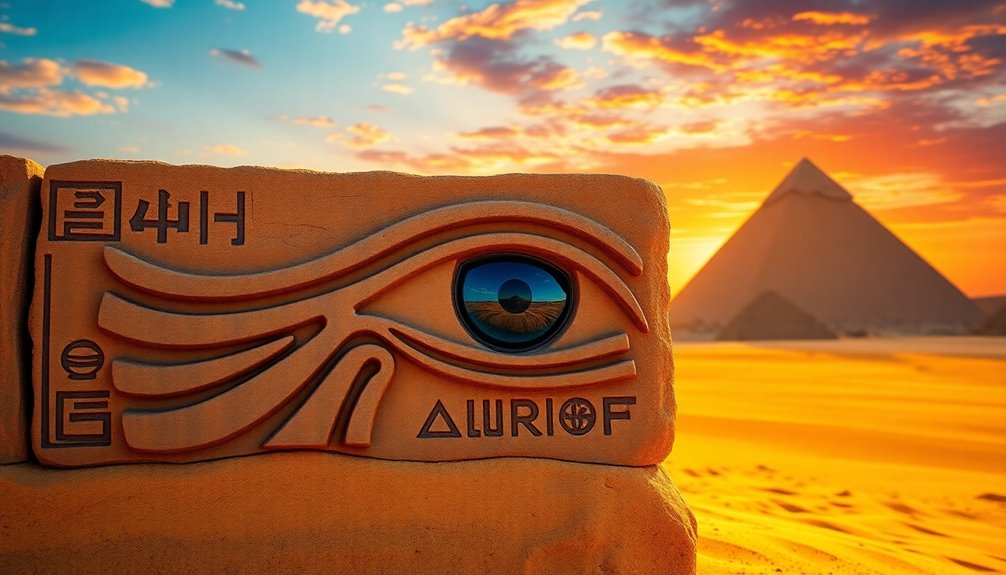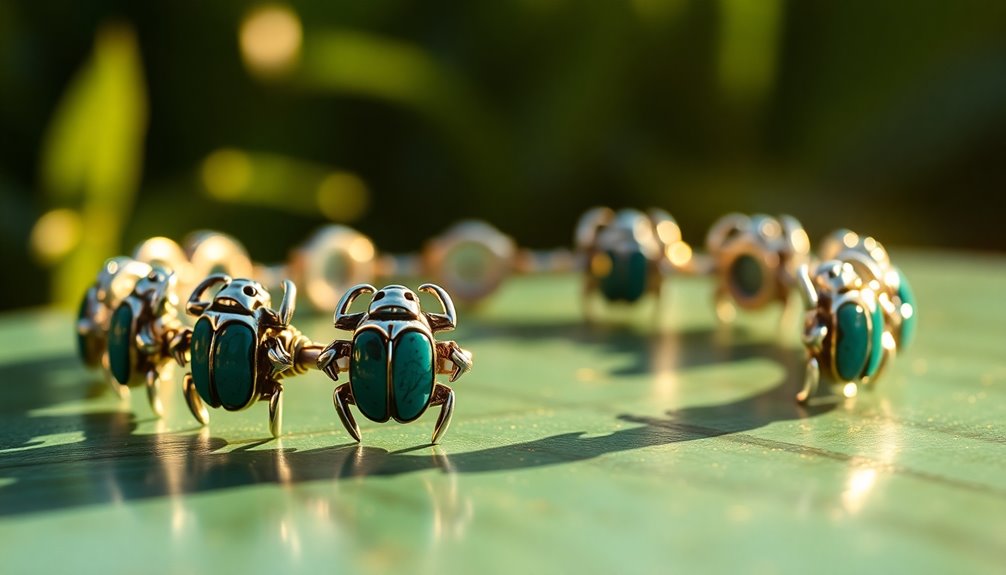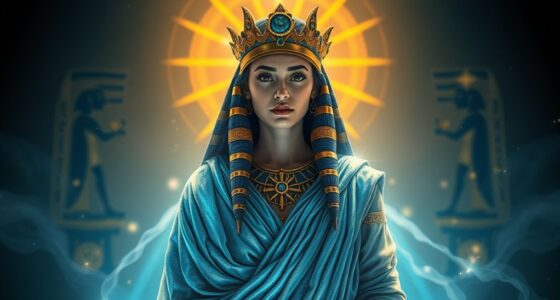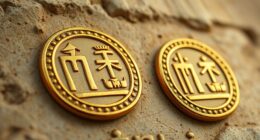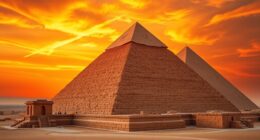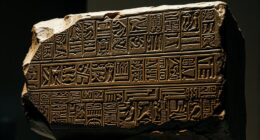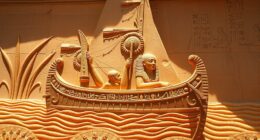The Egyptian cross, or Ankh, represents life, immortality, and the balance between earthly existence and eternity. Emerging around 3000 BCE, it's a significant symbol in ancient Egyptian culture, often depicted in the hands of deities, signifying their power over life and death. The Ankh combines the circle of eternity with the cross of earthly life, embodying themes of fertility and divine creation. Today, it also serves as a powerful emblem of cultural pride and empowerment, especially within the African diaspora. Stick around, and you might discover even more fascinating aspects of this ancient symbol.
Key Takeaways
- The Egyptian cross, known as the Ankh, symbolizes life, immortality, and the interconnectedness of physical and spiritual realms.
- It represents the union of opposites, balancing masculine and feminine forces, emphasizing harmony in existence.
- The Ankh is a central symbol in ancient Egyptian religion, signifying authority over life and death, often held by deities.
- It has evolved into a modern emblem of cultural pride and empowerment, especially within the African diaspora.
- The symbol has influenced early Christian iconography, resonating with themes of eternal life and resurrection.
Historical Origins of the Ankh

The Ankh symbol, often called the "key of life," traces its roots back to ancient Egypt, emerging around 3000 BCE during the Early Dynastic Period.
You'll find early examples in hieroglyphics and artifacts of the Egyptian civilization, showcasing its significance in the context of life and death. The Ankh serves as a triliteral sign in hieroglyphics, representing the sequence of consonants Ꜥ-n-ḫ, and has even evolved into the Coptic language as ⲱⲛϩ (onh).
Scholars debate its original form, with theories suggesting it might've represented a knot of flexible material or been linked to sandal straps, as depicted in Middle Kingdom illustrations.
Its adoption across various cultures, including the Hebrews, highlights its widespread relevance. The Ankh is closely associated with deities like Osiris and Isis, symbolizing life, fertility, and the afterlife, which underscores its importance in both spiritual and daily life.
As you explore its history, you'll see how the Ankh maintained its significance over time, evolving into a recognized symbol of immortality and life, resonating with many cultures even today.
Symbolism of the Ankh
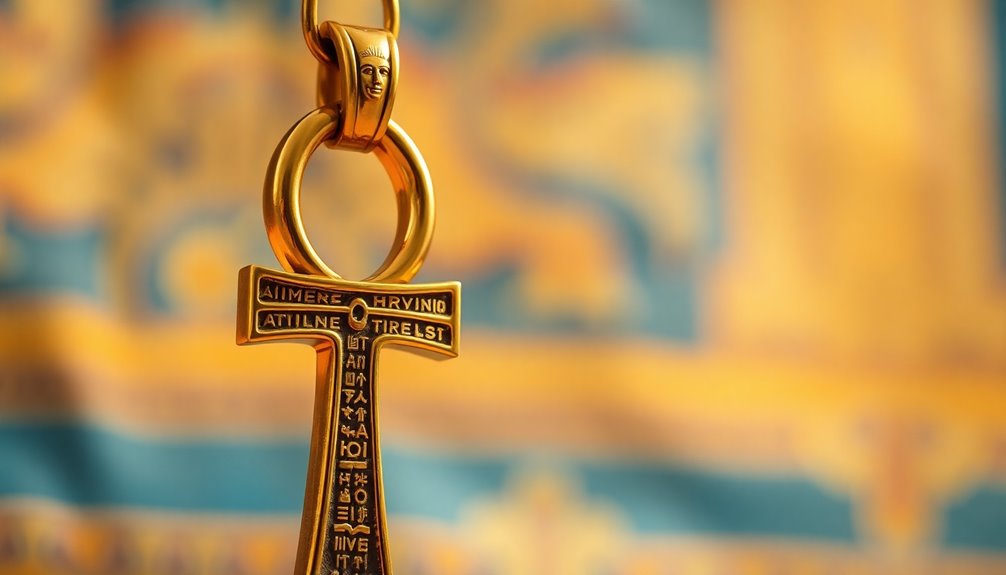
The Ankh stands as a powerful symbol of life and immortality, reminding you of the ancient Egyptians' belief in eternal existence.
It also represents the union of opposites, balancing the masculine and feminine forces in the universe.
As you explore its significance, you'll uncover how this iconic symbol relates to both the physical and spiritual domains.
Life and Immortality
In ancient Egyptian culture, an enduring symbol of life and immortality is the Ankh, often referred to as the "Key of Life." This powerful emblem embodies the belief that life continues beyond death, connecting the earthly domain with the afterlife.
You'll often see the Ankh depicted in the hands of deities like Osiris and Isis, highlighting its significance as a talisman for protection and guidance in the afterlife.
The Ankh combines a circle, symbolizing eternity, with a cross, representing earthly existence. This design beautifully illustrates the connection between life and immortality, emphasizing that life is a continuous journey.
In funerary art, the Ankh appears frequently in tomb inscriptions and artifacts, signifying the deceased's hope for eternal life and safe passage to the afterlife.
Moreover, the symbol is closely associated with fertility and creation, reflecting the ancient Egyptians' belief in the life-giving forces of nature and divine union.
Union of Opposites
Embodying a rich tapestry of meaning, the Ankh symbolizes the union of opposites, illustrating a profound balance between masculine and feminine forces. This ancient symbol connects the divine union of Osiris and Isis, showcasing how these opposing energies coexist harmoniously.
The Ankh's structure—a cross representing earthly life combined with a loop symbolizing eternal life—highlights the interconnectedness of physical existence and spiritual continuity.
In ancient Egyptian art, you often see deities holding the Ankh, reinforcing their role in maintaining the balance of life and death. This representation serves as a reminder that all aspects of existence are intertwined, from creation to mortality.
The Ankh also embodies themes of fertility, closely associated with the Nile's annual flooding, which was essential for agricultural prosperity.
As a powerful talisman, the Ankh reconciles opposing forces, allowing you to appreciate the balance inherent in life. Its enduring significance transcends cultures, inviting you to reflect on how the union of opposites plays a crucial role in your own journey.
Embracing these dualities can lead to a deeper understanding of life's complexities and the eternal nature of existence itself.
The Ankh in Ancient Religion
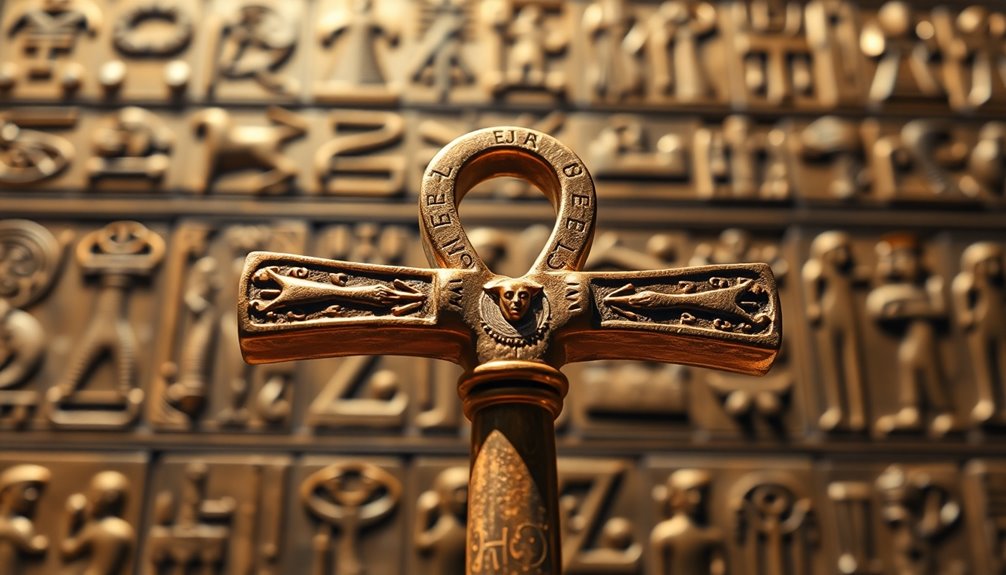
Representing eternal life and the connection between the physical and spiritual domains, the Ankh stands as a central symbol in ancient Egyptian religion. Known as the "key of life," the Ankh was much more than just a decorative emblem; it embodied profound beliefs in ancient Egyptian culture.
Frequently depicted in the hands of deities, this symbol signified their authority over life and death. Gods like Osiris and Isis often held the Ankh, showcasing their life-giving powers and the hope they offered to humanity.
In funerary art and rituals, the Ankh played a vital role. It symbolized the hope for immortality, guiding the deceased on their journey to the afterlife. As a potent amulet, it was believed to possess protective qualities, ensuring the continued existence of the deceased in the afterlife.
The Ankh's strong association with fertility and rebirth further established its significance, reflecting the ancient Egyptians' belief in the cyclical nature of life and the eternal soul. By understanding the Ankh's importance, you gain deeper insights into the spiritual beliefs that shaped ancient Egyptian culture.
Artistic Representations of the Ankh

When you explore artistic representations of the Ankh, you'll notice its powerful symbolism in ancient Egyptian art, often linked to life and the afterlife.
Artists skillfully incorporated the Ankh into various forms, from temple carvings to amulets, showcasing its significance.
Today, modern interpretations continue to reflect its unique shape and enduring meaning, bridging the gap between ancient beliefs and contemporary culture.
Symbolism in Ancient Art
The Ankh, often found in the vibrant tapestry of ancient Egyptian art, serves as a powerful symbol of life and immortality. You'll often see it held by deities and pharaohs, showcasing their divine power to give and sustain life.
In tomb paintings, the Ankh appears alongside other significant symbols like the djed and was, reinforcing its vital role in funerary contexts and the promise of life after death.
Artistic representations of the Ankh are rich with intricate details, emphasizing its associations with fertility and the divine. For instance, you might spot the goddess Isis grasping an Ankh, symbolizing rebirth and resurrection.
The Ankh's recurring presence in royal iconography highlights the divine right of pharaohs to rule. During ceremonies, they're often depicted holding the Ankh, signifying the blessing of life bestowed upon them by the gods.
Moreover, hieroglyphs featuring the Ankh in temple reliefs and artifacts serve as visual affirmations of the ancient Egyptians' beliefs.
These symbols encapsulate their cultural significance, melding concepts of life, death, and the afterlife into a cohesive narrative that continues to captivate us today.
Modern Artistic Interpretations
Modern artists reimagine the Ankh, blending its ancient significance with contemporary styles to create fresh interpretations. You'll find the Ankh incorporated into tattoos, where it serves as a powerful emblem of personal identity, cultural heritage, and spiritual beliefs—especially among individuals of African descent. This symbol of life and immortality resonates deeply, making it a popular choice for self-expression. Additionally, many music therapy for autism spectrum disorder practices emphasize the importance of symbols like the Ankh in fostering emotional expression and creativity. The use of the Ankh in these contexts highlights its role as a cultural symbol that transcends time and connects individuals to their roots.
Jewelry designers also celebrate the Ankh, crafting pieces that honor its historical roots while appealing to modern aesthetics. Artists often combine the Ankh with other symbols, like the Eye of Horus, to create unique, meaningful designs.
In fashion and home decor, you'll see the Ankh depicted in various materials and styles, showcasing its versatility as a representation of life, protection, and cultural pride.
Contemporary art installations take it a step further, using mixed media to explore themes of life, death, and interconnectedness. These innovative interpretations not only honor the Ankh's legacy but also resonate with diverse audiences, bridging cultures and reminding us of the enduring power of this ancient symbol. Additionally, many traditional healing practices are symbolically represented in modern artwork, reflecting the deep connections between culture and creativity.
Ankh as a Talisman

Many people view the Ankh as a potent talisman, believed to bestow protection and good fortune on its bearers. This ancient symbol of life has deep roots in Egyptian culture, where it was commonly used in amulets and jewelry. By wearing the Ankh, you're not just adorning yourself with a beautiful design; you're embracing its powerful attributes that promote health and well-being.
The Ankh's unique shape, combining the circle and the cross, symbolizes a balance between earthly life and eternity. This harmony is thought to bring peace and protection to those who carry it.
Historically, it was also associated with fertility and the afterlife, making it a staple in funerary practices, ensuring the deceased's safe journey into the next domain.
Today, many continue to adopt the Ankh as a talisman, especially within the African diaspora, using it as a symbol of cultural pride and empowerment. By incorporating the Ankh into your life, you align yourself with its rich history and powerful meaning, inviting a sense of protection and prosperity into your journey.
Modern Interpretations of the Ankh
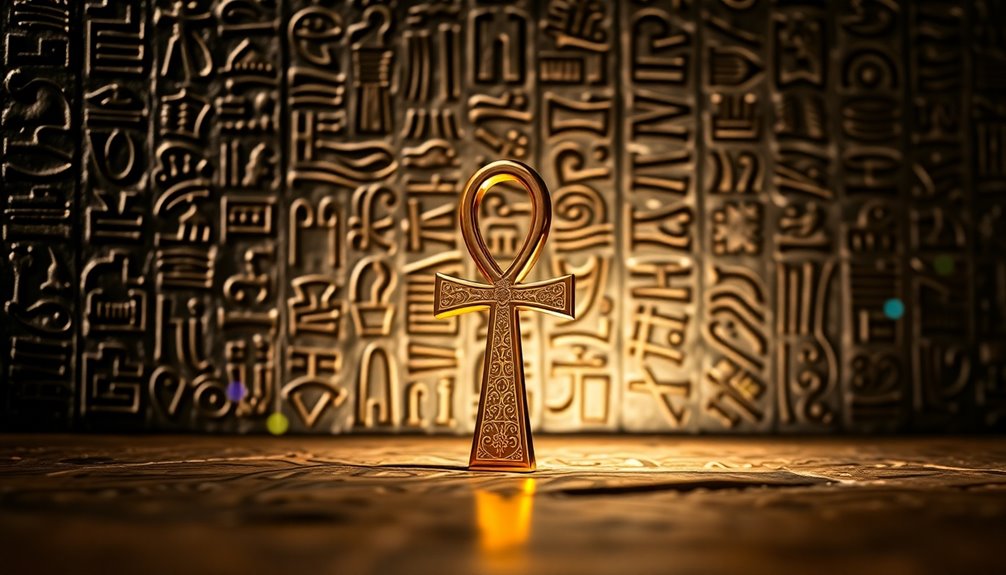
With its rich history, the Ankh has evolved into a powerful symbol in contemporary culture, resonating with individuals seeking connection to their heritage. This ancient Egyptian symbol, representing life and immortality, has found a modern place in fashion and body art. Many people now opt for Ankh tattoos as a way to express personal narratives and celebrate their cultural roots.
In today's world, the Ankh is embraced as a symbol of empowerment and pride, particularly among those of African descent. Wearing or using the Ankh is often seen as a connection to ancient Egyptian ancestry, fostering a sense of belonging.
Additionally, the symbol has gained traction in wellness and holistic healing practices, where it's believed to possess restorative properties.
Artists and designers have also integrated the Ankh into modern jewelry and fashion, creating pieces that blend ancient symbolism with contemporary aesthetics.
In spiritual and metaphysical communities, it's used as a talisman for protection and as a reminder of life's eternal cycle. Overall, the modern interpretations of the Ankh showcase its enduring significance and adaptability to the evolving cultural landscape.
The Ankh in Popular Culture
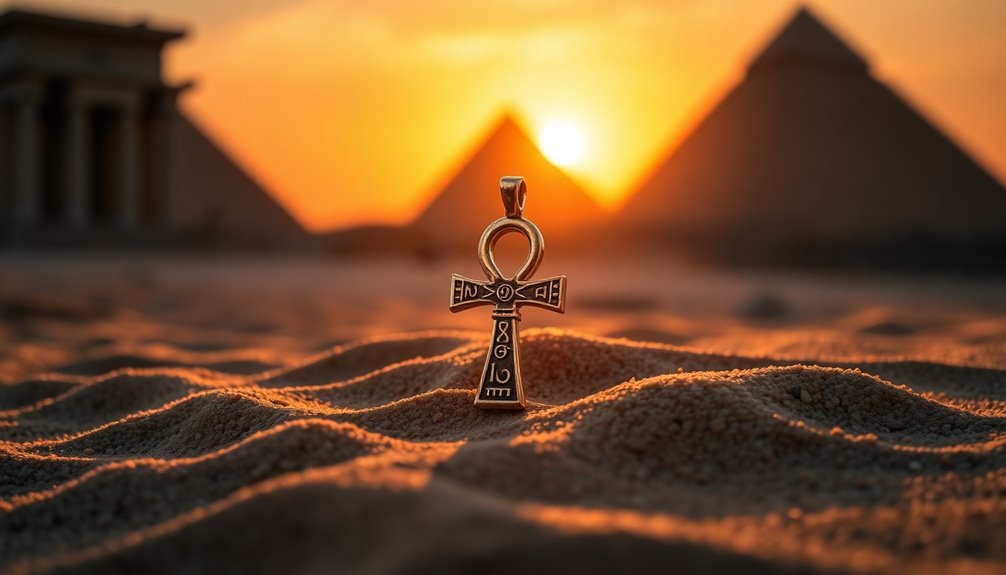
As the Ankh permeates various facets of popular culture, it has transformed into a universal emblem of life and strength, particularly resonating within the African diaspora. This ancient symbol of power has found its way into modern culture, manifesting in various forms that celebrate its historical significance.
You'll see the Ankh prominently featured in:
- Tattoos and Body Art: Many individuals choose the Ankh as a tattoo, representing life, strength, and cultural pride.
- Fashion and Jewelry: Designers incorporate the Ankh into accessories and apparel, symbolizing empowerment and a connection to ancient heritage.
- Media and Literature: Movies, music, and books often invoke the Ankh to explore themes of immortality and the afterlife.
Its adoption doesn't stop there; contemporary spiritual and wellness communities embrace the Ankh as a symbol of transformation and holistic healing.
Additionally, Kemetism and the goth subculture highlight the Ankh's revered status, showcasing a deep appreciation for ancient Egyptian beliefs.
As you explore modern expressions of the Ankh, you're engaging with a rich tapestry of cultural significance that transcends time.
Influence on Christianity
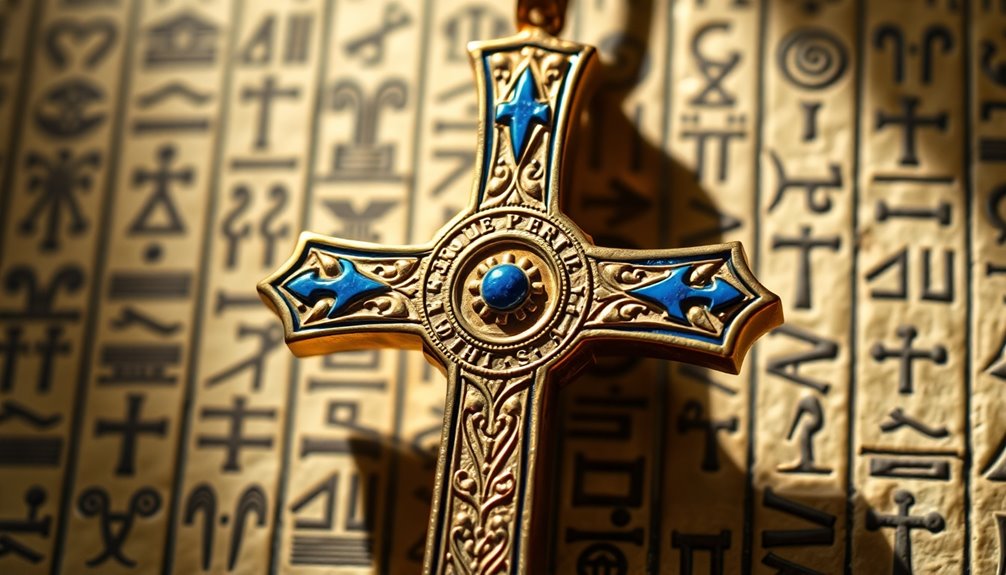
Although the Ankh originated in ancient Egypt, its influence on early Christianity is profound and enduring. The Ankh, often called the "key of life," became a crucial symbol of eternal life, resonating with the resurrection themes central to Christian beliefs. In early Christian art, you might notice the Ankh depicted alongside the traditional cross, emphasizing a shared symbolism of immortality and divine connection.
As Christianity in Egypt spread, Coptic Christians adopted the Ankh, using it as an emblem of faith and spiritual life. They managed to preserve its original meaning while integrating it into their new religious context. Notably, the Ankh is believed to have inspired the design of the staurogram, an early Christian symbol that combines the Greek letters "chi" and "rho," representing Christ.
Even today, the continued use of the Ankh in modern Christian iconography showcases its lasting significance as a symbol of hope and the promise of life after death.
This enduring legacy reflects how deeply intertwined the Ankh is with the evolution of Christian thought and practice, particularly in regions where its origins lie.
The Ankh in Wellness Practices
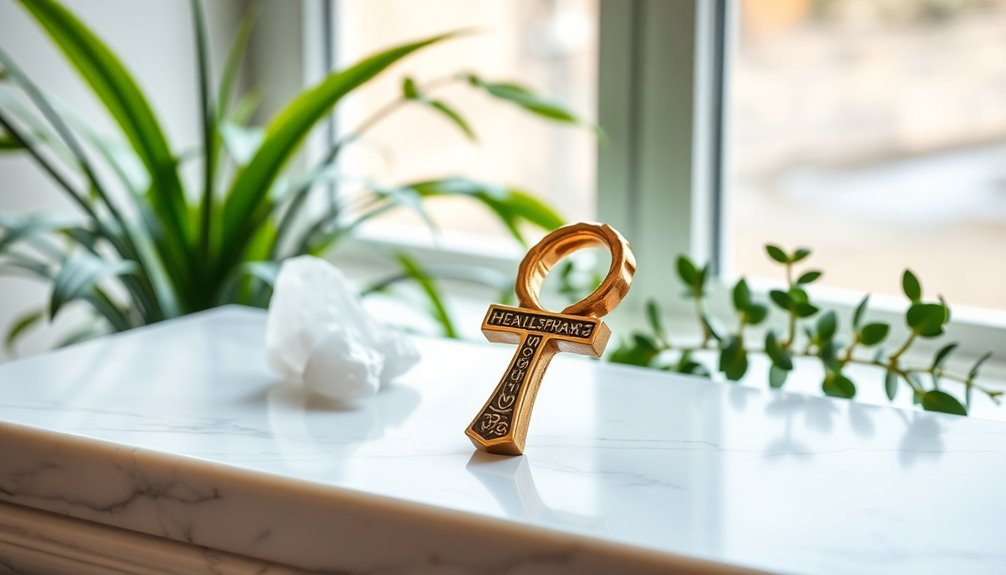
The Ankh's significance extends beyond its historical roots and Christian symbolism; it plays an indispensable role in contemporary wellness practices. This ancient symbol is often embraced for its representation of life, vitality, and healing. By incorporating the Ankh into your wellness journey, you can channel positive energy, promoting both physical and spiritual well-being.
Many holistic healing practitioners utilize the Ankh as a talisman, believing it enhances healing processes and protects against negative energies.
Here are some ways the Ankh is integrated into wellness practices:
- Symbol of Balance: The Ankh is seen as a bridge connecting the mind, body, and spirit, fostering holistic health.
- Empowerment in Art: Many choose Ankh tattoos and body art to symbolize personal empowerment and resilience in their healing journeys.
- Historical Significance: In ancient Egyptian medicine, the Ankh represented health and restoration, underlining the importance of life-giving forces.
Frequently Asked Questions
What Is the Meaning of the Egyptian Cross?
The Egyptian cross, known as the Ankh, represents life and immortality.
When you look at its design, you see a loop and a cross, symbolizing the connection between the earthly and spiritual domains.
This powerful emblem often appears in the hands of pharaohs and deities, signifying their control over life and the afterlife.
As you explore its meanings, you'll find it continues to symbolize health and protection in modern cultures.
Is Ankh a Good or Bad Symbol?
Imagine a radiant sun rising, casting light on ancient sands.
The Ankh is undeniably a good symbol, representing life, immortality, and fertility. It's often seen as a protective talisman, guiding souls to the afterlife while bestowing good fortune.
In modern contexts, it embodies empowerment and cultural pride, connecting you to your heritage.
With its enduring significance across various cultures, the Ankh shines brightly as a beacon of hope and positive transformation.
What Happens if You Wear the Ankh?
If you wear the Ankh, you invite a sense of protection and good fortune into your life.
This powerful symbol of life and immortality can enhance your spiritual connection and promote feelings of healing and energy.
Many wear it as a statement of cultural pride, linking themselves to their heritage.
You might also experience a deeper understanding of transformation and identity, as the Ankh resonates with the eternal cycle of life and existence.
What Does Wearing an Ankh Mean Spiritually?
When you wear an ankh, it's like carrying a piece of ancient wisdom with you.
Spiritually, it symbolizes eternal life and the connection between the physical and spiritual worlds. You're embracing themes of transformation and personal growth, releasing the potential for spiritual evolution.
This powerful talisman encourages you to seek balance and harmony in your life, reminding you of your inherent strength and the endless possibilities that lie ahead.
Conclusion
In exploring the ankh, you've uncovered a symbol that transcends time, much like an ancient tree whose roots dig deep into history while its branches reach toward the sky. This emblem of life and immortality still resonates today, reminding us of our own journeys and connections. Whether you wear it as jewelry or admire its artistic forms, the ankh invites you to embrace the cycles of life, just as the sun rises each day, bringing new possibilities.




